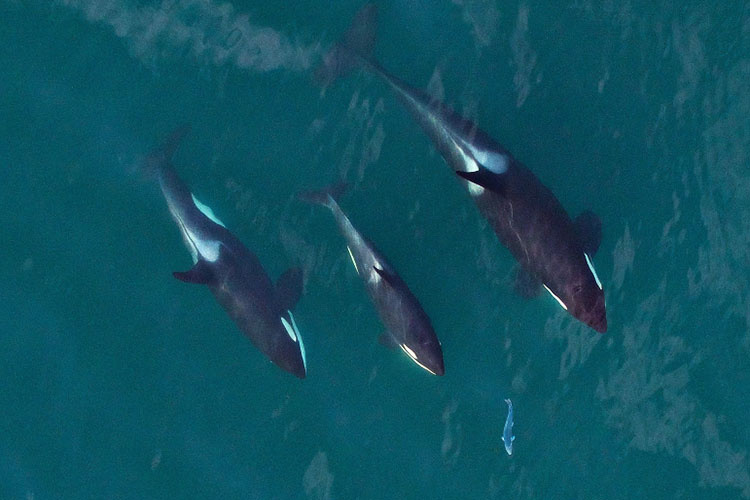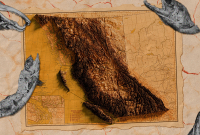Support strong Canadian climate journalism for 2025
A long-overdue federal strategy to tackle ocean noise is here at last — but some advocates say it falls short of what’s needed to protect species from the ever-increasing shipping traffic in Canadian waters.
Underwater noise from ships and industrial activity interferes with fish, invertebrates and more, but it’s best known for its effect on the ability of marine mammals — such as orcas — to navigate, communicate, socialize, find food and mates and avoid predators.
With major projects such as the Trans Mountain pipeline looming, the new Liberal government announced it was working on a strategy to deal with the issue in 2016 and promised a strategy and action plan by summer 2021. Three years after that deadline, the draft strategy is out. With each year of delay, shipping traffic continues to increase, particularly in rapidly developing areas like the Arctic. In the intervening years, the Trans Mountain pipeline expansion has been built and begun operating, driving an influx of oil tanker traffic in the Salish Sea.
The plan may have taken eight years, but Dyna Tuytel, staff lawyer with Ecojustice, says it’s still in some ways an exercise in buying more time — nine of the 20 recommendations relate to gathering information, studying, monitoring or collecting and reporting data to better understand the underwater noise problem.
“I'm concerned that they're … using the ongoing pursuit of perfect information as an excuse not to act,” Tuytel said in an interview with Canada’s National Observer.
The draft strategy was released on Aug. 23. Now, there is a 60-day consultation period for the public, Indigenous Peoples, partners and stakeholders to submit feedback. The next step is a federal action plan — to be published in 2025 — that will track the implementation of the strategy’s 20 recommendations, impose timelines and assign responsibilities to certain government departments and organizations.
“This is disappointing as it essentially means there will be more delays to seeing meaningful action rolled out, especially since the Government of Canada committed to incorporating the action plan with the draft strategy,” explained Kristen Powell, the World Wildlife Fund’s (WWF) specialist on marine conservation and shipping.
Tuytel says there are concerning parallels between this strategy and others like it that have failed to deliver.
“The Southern Resident killer whales have had an action plan since 2017 that sets out timelines and lead agencies for various actions — and the implementation of it seven years later has just been absolutely abysmal because no one is ultimately accountable and the timelines just go by without anything happening,” Tuytel said. “I’m really concerned that this action plan will meet the same fate as the Southern Resident action plan, of being this neglected document gathering dust."
With only 74 Southern Resident orcas left and myriad cumulative noise impacts to other species — both large and small — time is of the essence, according to conservation groups, in lowering the volume underwater.
“Marine life communicates through noise, so this becomes an ongoing challenge when you can't perceive your surroundings with sound,” said Powell, adding that research shows it impacts fish such as salmon and invertebrates.
“As we understand more in-depth what the long-term consequences of underwater noise pollution are, it is becoming increasingly urgent to implement a strong strategy for mitigating these impacts, because they're affecting several species at risk.”
Trans Mountain estimates its newly completed pipeline expansion will attract about 37 oil tankers each month. This increased total would represent about 14 per cent of today’s marine traffic in Port of Vancouver, according to the company. (Put differently, it’s a sevenfold increase in tanker traffic, specifically.) The Roberts Bank Terminal 2 project — the expansion of a major shipping container terminal in Delta, B.C. — is another megaproject with implications for underwater noise.
Shipping is also ramping up along the coast and elsewhere. B.C. is doubling down on the production and export of liquefied natural gas and climate change is opening up new shipping corridors in the Arctic, among other drivers of new traffic.
Despite concerns over implementation and timelines, the environmental groups are giving the government some credit for taking noise seriously. Overall, the draft strategy is “a really important first step forward in tackling the increasing issue of underwater noise,” Powell said. For the last four years, WWF ran a campaign on underwater noise and made submissions to help shape the federal strategy. Some of the language they pushed for is in the strategy.
“It contains several important elements that are required to finalize a strong and actionable strategy,” Powell said. Some of these recommendations include addressing knowledge gaps, promoting innovative technologies to reduce noise, expanding and standardizing data collection and reporting, and ensuring the federal government clearly lays roles and responsibilities.
“However, it's not clear how the research and innovation will lead to meaningful and measurable action at this time,” she said.
To Oceans North, a charity that focuses on conservation in the Arctic and Atlantic regions of Canada, the draft strategy is “a good start.”
“We're happy to see that the strategy acknowledges the success of the existing programs in the Arctic, where communities have really taken the initiative in the monitoring management of ocean noise,” said Amanda Joynt, senior policy advisor with Oceans North, in an interview.
“What the strategy is really showing is basically that there's existing tools already for management of underwater noise,” Joynt said.
“It's showing us that even without the strategy, communities — especially in the Arctic — have taken the initiative to actually manage ocean noise and shipping traffic on their own, with the tools that are available to them.”
One of the strategy’s three main themes is “science, knowledge gathering and innovation,” and while there are always information gaps to fill, conservation groups don’t want research to come at the expense of meaningful action.
“There's a lot of really good reports, there's been a lot of good academic science that's come out in the last decade on impacts of underwater noise,” Joynt said.
“We're further ahead than we think we are, and we can move probably faster than we think we can on this issue with the tools that we have.”
A legal analysis by East and West Coast Environmental Law (commissioned by WWF) found Canada could use its existing legal tools to crack down on ocean noise pollution in the near term.
For example, it says the Department of Fisheries and Oceans could develop marine environmental quality standards and requirements for ocean noise under the Oceans Act and apply it nationally with noise limits specific to Arctic, Atlantic and Pacific regions.
The Vancouver Fraser Port Authority is in the process of reviewing the federal government’s ocean noise strategy and will be providing feedback in the coming weeks, a spokesperson said in an emailed statement to Canada’s National Observer.
Natasha Bulowski / Local Journalism Initiative / Canada’s National Observer
This article was updated on Aug. 28 to correct Dyna Tuytel's job title.






Comments